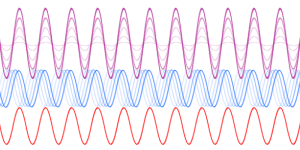Interference

Figure 1: Phasing effects: Combination and Cancellation
Interference
Interference occurs when two waves move simultaneously through a medium. They can interfere constructively, destructively, or produce a resultant of zero.
Whenever waves originating from two or more sources interact with each other, there will be phasing effects leading to an increase or decrease in wave energy at the point of combination. When elastic waves of the same frequency meet in such a way that their displacements are precisely synchronized (in phase, or 0 degree phase angle), the wave energies will add together to create a larger amplitude wave. If they meet in such a way that their displacements are exactly opposite (180 degrees out of phase), then the wave energies will cancel each other. At phase angles between 0 degrees and 180 degrees, there will be a range of intermediate stages between full addition and full cancellation.
When a signal on two different paths to the receiver passes, (a direct and a e.g. on the ground reflected signal), then there will also be a superposition of both waves. The waves propagate with the same speed. Since the reflected wave has traveled a longer path than the non-reflected wave, the reflected wave reaches the input of the receiver always later than the direct wave. Because the reflection conditions are rarely constant, it is possible that by the resulting differences in the phase, all cases of the superposition of both waves can occur from out of phase opposition to in-phase. This results in a fluctuating and distorted received signal, which changes a function of time. Such a result is known in radio engineering as a loss (fading), and this interference effect occurs frequency selective, theoretically, it relates to only one frequency. However, by the time dependence of the process, the fading phenomena contribute but most of the total bandwidth of the received signal.
Since radar echo is received for a very short period of time, caused by reflection interference either strengthen or weaken the radar pulses. Because the reflected part of the echo signal must arrive a little later by the detour, sensitive systems may recognize this case. By the multipath receiving and measurement of this time delay difference, even the height of the aerial targets are calculated, theoretically.

